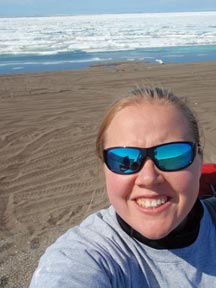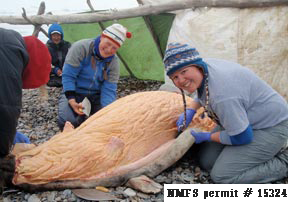Amelia Hunt, College Intern I
Wildlife Conservation - Fairbanks

I just graduated from the University of Alaska Fairbanks with a BS in Wildlife Biology & Conservation. I spent the last two years of my undergraduate studies working with the Arctic Marine Mammal Program at Fish & Game as a College Intern I.
This internship kept me on my toes with a constant influx of tasks. The main portion of my job entailed processing marine mammal stomachs, inventorying new tissue, and preparing tissues for shipment.
Processing marine mammal stomachs meant that I had to sort through the stomach content of any marine mammal that came in and identify prey items as best as I could. While going through marine mammal stomachs, I learned a lot about the various invertebrates that we have in the arctic waters of Alaska as well as what I am most likely going to find in each stomach I process. Bearded seal stomachs were the coolest stomachs to go through because they always had a vast variety of interesting invertebrates to look at. The process of sorting stomach contents has taught me the importance of properly labeling things and has provided me knowledge about some of the creatures that live in the oceans.
Working closely with native subsistence hunters, we have a steady supply of seal tissues. When a shipment came in, we would sort through each specimen and subsample it for the museum or other projects we had going on at the time. It was also our responsibility to label everything correctly and obtain as much information as we could about each specimen. Inventorying has taught me the importance of properly labeling things and keeping things organized for ease of use in the future.
Preparing tissues for shipment, while sounds easy, actually involves a considerable amount of work. We had to inventory the samples; check, double check, and triple check the shipments to make sure that they were correct. This is when the importance of labeling and organization became so apparent. When we kept things organized, preparing tissues for shipment was a breeze.

My most unique experience was being able to do field work in Point Hope for 2 weeks. During those two weeks, I monitored beaches for new kills. When we found families with fresh seals we would help them pilaaq (skin) the seals using the traditional native tool, the ulu. Once the seal was skinned and the families took what they needed, we would collect the other internal organs for our sampling. Once samples were collected, I recorded all the data I could obtain on each specimen. If we collected a blood sample, we then needed to spin it back at base. Those two weeks in Point Hope are ones I will always remember fondly!
This internship has reinforced my passion for marine mammal research. It has given me valuable lab and computer experience that will aide me in future job prospects. The past two years working with the Artic Marine Mammal Program has been amazing! Everyone in the department is friendly and that contributed to making the internship a wonderful and fulfilling experience.
